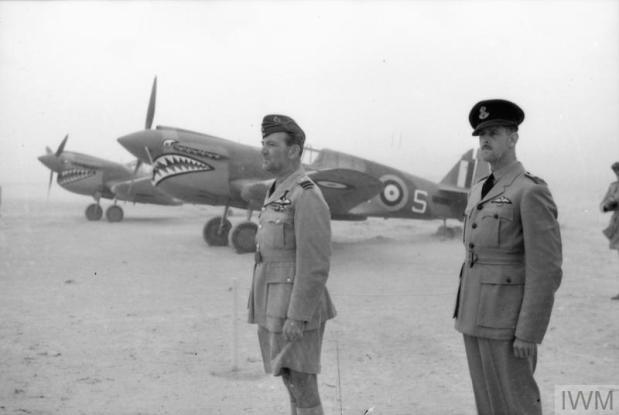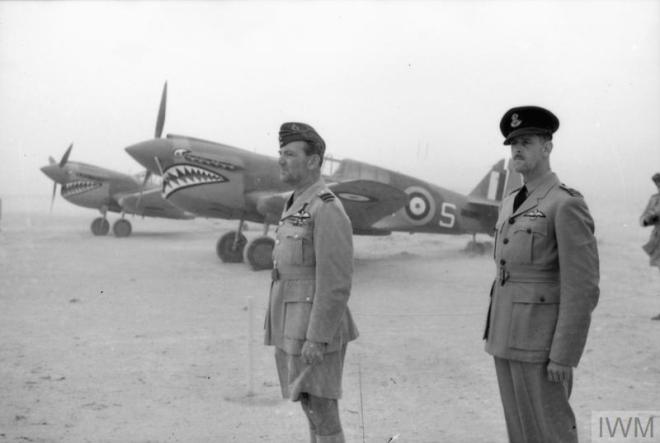In a previous post (at this link) I have provided some information on BenCol, the ad-hoc formation thrown together for a left hook movement towards Benghasi, to cut off the Axis fighting forces in the Gazala line. In the end this came to nothing, because of the rapid Axis retreat. BenCol was still assembled but simply pursued the retreating Axis, rather than enveloping them.
Today, in Air Marshal Tedder’s papers from the National Archive, I came across the original objective for BenCol, in a message sent to Tedder, the Air Officer Commanding-in-Chief Middle East, by Air Vice Marshal Arthur ‘Mary’ Coningham, on 27 November. I thought this might be of interest, particularly in the context of the oft-voiced criticism of the British army as somewhat plodding and not given to deep raids.
Air Vice Marshal A Coningham, Air Officer Commanding, Western Desert, and Squadron Leader C R “Killer” Caldwell, Officer Commanding No. 112 Squadron RAF, watch the parade (off camera) during a ceremony at which Coningham presented the Squadron with its badge, at Sidi Heneish, Egypt. Two Curtiss Kittyhawk Mark Is, bearing the Squadron’s ‘Sharkmouth’ insignia, can be seen parked behind them. CM2842 of the IWM Collection. This picture was taken in March 1942, a few weeks after the end of Operation CRUSADER.
The first part of the letter covers Coningham’s view of the events that occurred around Rommel’s ‘raid to the wire’, the ill-fated attempt to smash the Commonwealth forces following the victory in the tank battle at Sidi Rezegh on Totensonntag. I’ll post that some other time.
MOST SECRET & PERSONAL
AIR HEADQUARTERS
WESTERN DESERT
27 November 1941[…]
-2-
About my signal last night concerning a Benghasi project. I appreciate the position briefly as follows:
(i) The enemy’s re-action to our Jerabub operations indicates that a successful attack on his base at Benghazi would be fatal for him. The German has shown what he would do were he in our position by the way he has been expecting us to do the same, i.e. to attack Benghasi.
(ii) The defences at Benghasi are very thin and there are no ground forces that could stnd up to a column containing AFVs.
(iii) We have ample air superiority to spare the fighter force necessary to ensure the protection of the column and air superiority over Benghasi.
(iv) Owing to the uncertainty of the ground position the bomber force cannot be used fully.
(v) Success at Benghasi would lead to success at Derna and would effectively stop reinforcements from Tripoli.
(vi) Any disappointment felt at the present lack of success would be more than balanced by such an effective stroke.
I have discussed the projectw ith and Sandy and Neil Ritchie and they are keen. Miller says that he can do the “Q” side all right. My proposal is to send five fighter squadrons consisting of three Tomahawk and two Hurricane squadrons to be joined on the second day by 33 Squadron which is now at LG 125. We shall, therefore have the same sized force which it was intended should go on to Tripoli. It would be be possible by fighter conrol at Benghasi to make an air pincer movement on the Derna area, at the same time holding off reinforcements from the SW. The bombers would remain in action in the East until sent for.
The Army plan would be to send a Brigade consisting of 50 or 60 American tanks and sufficient forces to take over and hold Benghasi. We should make the journey in three hops, directly West from here. It will be done irrespective of the mopping up of the enemy forces now sculling round the desert.
I am going into the problem more fully to-day and tomorrow and then shall run up in the Blenheim to see you for a couple of hours so as to put you fully in the picture.
Yours sincerely
Mary
Some observations on the above:
- The strength of the forces at Benghasi, despite reinforcements, would probably not have been enough to hold against a tank force. The idea however of sending M3 Light Tanks appears quite strange, given their extremely high petrol consumption and consequent short range.
- The idea that a major battle would be fought around Derna indicates that there was little understanding of the geography and how it affected combat operations in 8 Army/R.A.F. Middle East H.Q. during the early stage of CRUSADER. Derna was not a place where a force could make a stand, it could be outflanked to the south very easily. In the event, nothing happened there, the Axis retreated straight from the Gazala line to Agedabia.
Air Marshal Coningham’s biography, at this link.


